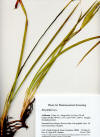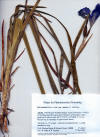| USDA ARS Record of Procurement for Antitumor Active
Species of Iris
Iris
douglasii
Iris missouriensis
Iris
virginica
Wong S. M., C.
Konno, Y. Oshima, J. M. Pezzuto, H. H. Fong and N. R. Farnsworth 1987.
Irisones A and B: two new isoflavones from Iris missouriensis. J.
Nat. Prod. 50(2): 178–180. “Two new isoflavones,
irisones A and B, together with the known compound,
5,7-dihydroxy-2',6-dimethoxy isoflavone, were isolated from the roots of
Iris missouriensis. With the help of 2D-homonuclear-J-correlation
and 2D-nOe experiments the structure of irisone A was deduced to be
5-hydroxy-2'-methoxy-6,7-methylenedioxy isoflavone. The structure of
irisone B was elucidated by spectral analyses as
2',5-dihydroxy-6,7-methylenedioxy isoflavone and was confirmed by chemical
conversion to irisone A.”
Wong S. M., J.
M. Pezzuto, H. H. Fong and N. R. Farnsworth. 1986. Isolation and
characterization of a new triterpene from Iris missouriensis.
J Nat Prod. 49(2): 330–333.
Wong S. M., J. M.
Pezzuto, H. H. Fong and N. R. Farnsworth. 1986.
Plant
anticancer agents XXXIX:
Triterpenes from
Iris missouriensis (Iridaceae). J Pharm Sci. 75(3): 317-320.
“Employing
the roots of Iris missouriensis, two known triterpenes,
iso-iridogermanal and zeorin, were isolated and identified. As presently
reported, they were found to demonstrate cytotoxic activity toward
cultured P-388 cells (ED50 = 0.1 and 1.1 microgram/mL, respectively).
Additionally, a new triterpene that demonstrated an ED50 of 8.5
micrograms/mL was isolated. On the basis of spectral analysis and chemical
correlation with zeorin, the structure was shown to be 6 6 alpha-hydroxy-A'-neogermmacer-22(29)-en-30-oic
acid (missourin).”
Wong S. M., J. M.
Pezzuto, H. H. Fong and N. R. Farnsworth. 1985.
Isolation,
structural elucidation, and chemical synthesis of
2-hydroxy-3-octadecyl-5-methoxy-1,4-benzoquinone (irisoquin), a cytotoxic
constituent of Iris missouriensis. J. Pharm. Sci. ;74(10):
1114–1116.
“As
part of a continuing effort to provide novel agents of potential value in
cancer chemotherapy, 2-hydroxy-3-octadecyl-5-methoxy-1,4-benzoquinone (irisoquin)
was identified as a component of Iris missouriensis. This novel
species demonstrated cytotoxic activity with cultured KB and P-388 cells
(ED50 = 1.8 and 0.03 microgram/mL, respectively). The structure was
assigned on the basis of spectral analyses and The structure was assigned
on the basis of spectral analyses and confirmed by chemical synthesis. The
latter provides a facile method for the production of irisoquin and
structural derivatives that may be of value for the examination of
structure-activity relationships. A closely related compound,
3-octadecyl-5-methoxy-1,4-benzoquinone (deoxyirisoquin), was also isolated
from Iris missouriensis, prepared synthetically, and found to be devoid of
cytotoxic activity.” |










